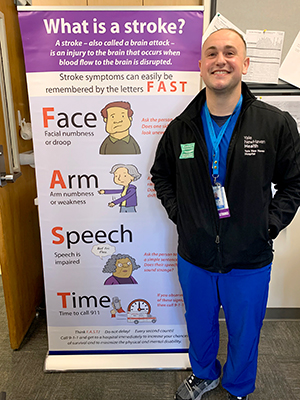
Popular Locations
- Yale New Haven Children's Hospital
- Yale New Haven Hospital - York Street Campus
- Yale New Haven Hospital - Saint Raphael Campus


Justin Blood, RN, stroke nurse navigator and Connecticut Army National Guard member, identified subtle stroke symptoms in a fellow soldier at a recent weekend drill and got him to the hospital quickly.
The symptoms could have been mistaken for something else.
Justin Blood, RN, a Yale New Haven Hospital nurse and medical provider with the Connecticut Army National Guard, was participating in a monthly drill with fellow Guard members Oct. 16 in Niantic.
A soldier with the 192nd Military Police unit came to him describing “very vague symptoms” that included weakness in both legs. The soldier had completed the Army Physical Fitness Test the day before, but Blood didn’t think that explained his symptoms – especially after the weakness transitioned to just one leg.
“I was immediately concerned about stroke,” said Blood, who became a nurse navigator with the Yale New Haven Stroke Center six months ago. “I told my leader, ‘I’m taking him to the hospital.’”
On the way to the Lawrence+Memorial Hospital Emergency Department, the man’s symptoms worsened, with weakness traveling to his upper extremities. When they arrived, Blood helped him walk into the ED.
Clad in Army fatigues, Blood had to quickly explain his YNHH role and said, “I’m calling a stroke code.” He relayed the soldier’s symptoms and other critical information, and the L+M ED staff immediately went into action.
“Huge kudos to the L+M team,” said Blood, himself a former ED nurse at YNHH’s Saint Raphael Campus. “They knew exactly what to do, and they were so quick. Throughout the experience, the nurses kept the patient informed about what was happening and his plan of care.”
Using the Yale New Haven Telestroke Service, the L+M care team contacted the Stroke Center and reached Joseph Schindler, MD, director of the Stroke Center and Telestroke Service and clinical chief of the Division of Vascular Neurology, Yale School of Medicine.
The service allows Yale New Haven stroke specialists to examine patients remotely and review diagnostic images, lab results and other information to recommend a plan of care. In 2008, L+M became the first hospital to implement Telestroke, which now serves hospitals throughout Connecticut and in Rhode Island.
After reviewing the soldier’s test results and images and consulting with the L+M team, Dr. Schindler advised them to administer tPA, a clot-dissolving medication. The patient’s symptoms soon improved.
Of course, treatment can’t begin until the patient gets to a hospital, which is why everyone should know the signs of stroke, Blood said. People should also be aware that a person having a stroke might display only one sign or a combination of signs, and that signs can be subtle (see graphic).
“Even if you’re not sure it’s a stroke, get help immediately,” he said.
Yale New Haven stroke nurse navigators and the stroke service work hard to educate patients and families and identify gaps in health care. This greatly improves patients’ health literacy and overall health, Blood said.
He is still amazed that he happened to be the medical provider on duty when the soldier experienced the initially vague symptoms.
“I’ve never experienced anything like it,” Blood said. “It’s like the stars aligned, and I was there at the right time. I’m glad he’s doing OK.”